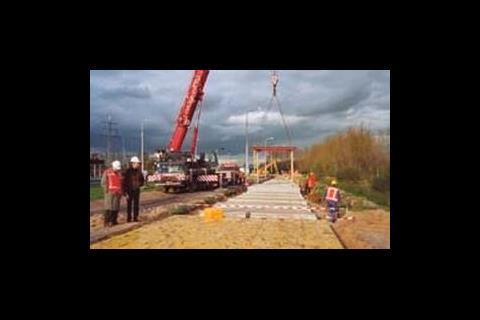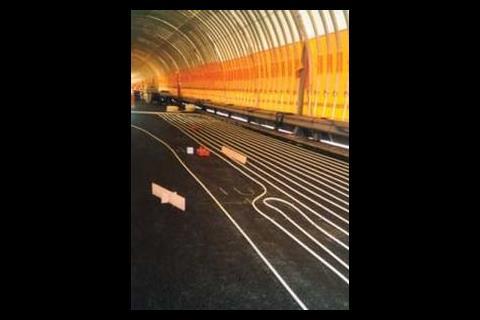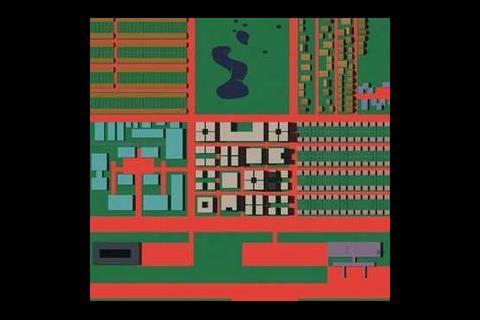With the arrival of a Labour government many of our profession and industry felt confident that there would be a new awakening. Until the recent wind-of-change there had been a growing disappointment. At our finger tips is a well tried and tested technology: the ability to collect, store and distribute solar energy in the earth and within the structures of our own built environment.
Vision is lacking, according to the Institution of Civil Engineers, in virtually every aspect of our nation's infrastructures. As a society we are failing to deliver sustainable energy programmes to ensure a healthy and balanced environment. Although the government sets great store by integration, there is delay and uncertainty and little evidence of joined-up thinking. A healthy dose of realism is being asked to encourage a shift in public understanding and perception.
This is the nub of the Institute's, The State of the Nation 2003 annual report 2. It constructively challenges government, other professional bodies and society at large to take a reality check on a wide range of issues. School grades of A (good) to E (bad) were given and the results are very poor. Water and flood management get a B+. Yet energy, waste, integrated transport, urban regeneration and design are all moving into the dunce's class. The report is a timely wake-up call for everybody.
Building services and energy engineers might well agree that to obtain a co-ordinated, long term, sustainable approach it is critical that the drivers of change are not fuelled by political agendas and that all energy options must be taken into account and fully integrated. But pouring cold water on the government's hopes for renewable technologies and energy conservation to bridge what the Institution of Civil Engineers consider an impossibly large generation shortfall will get us nowhere. This negative aspect of the report goes contrary to the underlying message of coupling vision to real-time technologies.
Over the past 40 years the benefits of wind, wave, solar and, to a degree, energy conservation was not taken seriously by successive UK governments. Coal, oil, gas and nuclear still remain the political and industrial drivers regardless of our knowledge that all these energy providers are destroying our natural environment. Currently our generation mix of electricity is approximately 32% (mainly imported) coal, 23% nuclear, 38% gas, 4% oil and the remaining 3% a mixture of renewable technologies.
The announcement by the UK government of a massive programme in offshore wind turbines is laudable, especially when current expansion can generate the same electrical power as six nuclear power stations. Any critique of the costs of turbine maintenance must be balanced against the high costs of decommissioning nuclear power stations. The clear up of 50 years of nuclear waste at Harwell Atomic Research Establishment has so far cost £60 million. What the cost will be at the assumed completion in 2020 will doubtless take people's breath away. When assessing renewable technologies such environmental impact costs were often played down or even ignored when comparing the total social, economic and life cycle costs 3.
One of the most exciting initiatives currently underway is the Icity concept developed by Icax. This UK technology innovation company coined the term 'interseasonal heat transfer'. The concept takes a holistic view of the patterns of generation and consumption of energy in cities. The Icity model (see figures 1 and 2) demonstrates that the city, in its current form, is an enormous potential collector and store of solar energy. The buildings, streets and surfaces of the city are all potential energy collectors, and the ground below is a giant repository both of heat and coolness.
"It is time that we stopped thinking about energy as a fuel commodity only, burnt and then sold per unit to the customer, says Mark Hewitt, director of Icax. "The only viable energy sources for the long term are those derived from the massive existing geophysical forces: wind, waves and sun. Sustainability is not about energy saving, it is about using benign energy sources in a responsible manner." Icax is working on demonstration projects in the UK in both the transport and education sectors.
Over the past 40 years many British architects, building services and energy engineers have gone back to first principles of design and developed ways and means for large buildings to be naturally ventilated. They have shown that domestic housing can become energy self-sufficient while their work has become the trigger for investment and job creative technologies beyond our own frontiers. But to date all our efforts are piecemeal compared to what has taken place in Denmark, Sweden, Germany, Spain and the Netherlands.
In these countries infrastructure, energy, transport, housing and health are all inter-linked. There is a clear and concise interaction between technical and financial institutions of government, university research, commercial institutions, construction companies and public agencies. In the Netherlands getting the mix right has been essential. The country has developed use of a variety of solar driven technologies: from low-noise wind turbines for domestic use, to large-scale offshore turbines interacting with zero-energy designed social and private housing 4. There is a ground water system to serve the 85 hectare Inner-city campus of Eindhoven's Technical University, as well as a new building block of solar energised roads and urban infrastructures 5.
As the Icity concept illustrates, roads, airport tarmacs, school playgrounds, shopping centres and car parks can be seen as mass collectors of free energy from the sun. Over the past five years the Dutch have developed solar techniques along motorways and roads. Photovoltaic panels set on top of acoustic barriers can direct electrical power to the national grid or act as a catalyst by mixing water and dc current through an electrolyser to produce and store hydrogen for fuel-cell driven vehicles 6.
Furthermore, it has been successfully demonstrated that roadways and airport runways can collect and store solar energy to make them snow and ice-free in winter, with the benefits of a longer life and the ability to supply energy to adjacent buildings.
In 1998 a survey made by the Fujita Research Company of interseasonal heat transfer in Europe, based on analysis of applications for heating buildings, concluded that the technology was an important step in the development of sustainable communities and energy self-sufficient buildings. While the projects were experimental and funded by government departments, Fujita concluded that the technology worked, was commercially viable and such technology would become a major growth area in European construction within 15 years.
In the same year as the Japanese report, the Dutch scored their first success when coils of specially fabricated polyethylene-bonded, reinforced pipes were embedded under the surface of a new lock road in Zeeland. Water was transported from 60-80 m deep sand layers. With air temperatures as low as 12-15°C, water temperatures in the underground pipes rose to an excess of 50°C corresponding to an energy yield of 80 W/m2/h. At the time not only was the road kept free of ice and snow, with all the relevant advantages, but there was found an extra bonus of surplus sustainable energy to heat or cool 100 family houses or the commercial equivalent for every kilometre of constructed road (see figure 3).
A most recent example is a 600 m long service road to a factory estate built by the Apeldoorn Council which will provide surplus energy for 12 factory units of 50 000 m2. In the North of Holland, a family company Ooms Avenhoorn BV, developers and manufacturers of modified bituminous binders, road and underground pipe constructors – including the taxi and runways at Amsterdam's Schiphol airport– are celebrating their centenary by being the first company in the world to extract solar collected energy from asphalt-concrete and inserted pipe-work system to heat their own headquarter offices and research buildings with winter snow free roads. Ooms Avenhoorn BV, are now supplying their particular system of road energy to schools, old people's homes and housing estates throughout the province of Noord Holland.
Learning from others
Stimulated by the Roads to the Future 8 project, initiated and financially supported by the Dutch Ministry of Transport, Public Works and Water Management in 2000, designers and manufacturers have pushed the frontiers even further. Tested on a major motorway one of the leading edge developments has been a prefabricated concrete modular intelligent road system known as ModieSlab. As well as providing all the benefits for drivers and surplus energy, the system will also include fast water drain-off, traffic control systems, safety lighting modules, electronic guidance systems and energy storage held in deep piles that overcomes the problem of different soil conditions along a motorway system.
With Government backing, everything is on the fast track. Plans are advanced for the Dutch Highways Commission to construct an 18 km six lane new section of the A9 ring road in South-East Amsterdam that will be able to supply 40 000 housing units with sustainable energy and give an important boost to an area where social housing is vital.
Here in Britain, a recent internal feasibility study produced by Dr Derek Carder of Transport Research for Les Hawker, head of pavement engineering at the UK's Highways Agency has recommended that a demonstration project be undertaken to investigate the practicality of using this technology for the UK's road system.
Andrew Ford of Icax says: "This technology has huge potential for both new and retrofit road's in the UK as well as other transport infrastructures such as airports. It can be deployed to make our roads a significant provider of renewable, non-carbon emitting energy, transforming the real value of our road infrastructure. As the Dutch have found roads are made safer and last longer. We are pleased that government and other agencies are becoming aware of this potential."
The Institute of Civil Engineers' president, Professor Adrian Long, and his team are timely with their State of the Nation 2003 message. Agreeing that environmental and social aspects are being addressed, they believe that economic issues are being fudged. A greater emphasis needs to be given to upgrading the overall standard of the urban environment, rather than focusing on the very best and the very worst. They say that further funding is needed to halt and reverse road network deterioration, and that to secure the UK's energy supply all options of fuel diversity need to be considered.
Building services, environmental and energy engineers are fully aware that knowledge and tools are fully within their reach. Time then, to educate politicians, prime movers and the public that viable and economic answers are available! Time for CIBSE and other professional institutions to come up with their ideas on the State of the Nation! Perhaps it is time for engineers to share their knowledge and work collectively to educate the government about what's possible, and achievable.
Source
Building Sustainable Design
Reference
1 'Rolls Royce performance: Festival Hall heat pump, Bill Holdsworth, AJ , May 2001.
2 ICE 'State of the Nation 2003 Report'. www.ice.org.uk
3 'Atomic reaction: nuclear clean up', New Civil Engineer, 3 July 2003.
4 'Opting for change: sustainable building in the Netherlands', Hal/de Vries/Brouwers, AENEAS 2000.
5 'Cool thinking', Bill Holdsworth, European Foundations, Spring 2003.
6 'Renewable hydrogen', Nina Morgan, REFOCUS, May/June 2003.
7 'The heat is on the street', Bill Holdsworth, Construction News, 5 November 1998.
8 'Renewable energy roads', Bill Holdsworth, REFOCUS May/June 2003
Postscript
Bill Holdsworth has been a professional building services engineer for over 40 years with his own international practise. He was instrumental in developing solar and other renewable energy systems in the early 1960s. In the late 1970s he developed a design matrix for healthy building systems and is author of a number of books on climatic adaptive architecture and energy systems. Currently active with encouraging the UK government and other agencies to foster renewable and solar energy technologies, he now lives in The Netherlands where he has become a writer, journalist and lecturer worldwide.



























No comments yet